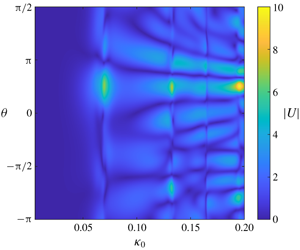Article contents
Wave diffraction by multiple arbitrary shaped cracks in an infinitely extended ice sheet of finite water depth
Published online by Cambridge University Press: 21 April 2020
Abstract

Flexural-gravity wave interactions with multiple cracks in an ice sheet of infinite extent are considered, based on the linearized velocity potential theory for fluid flow and thin elastic plate model for an ice sheet. Both the shape and location of the cracks can be arbitrary, while an individual crack can be either open or closed. Free edge conditions are imposed at the crack. For open cracks, zero corner force conditions are further applied at the crack tips. The solution procedure starts from series expansion in the vertical direction based on separation of variables, which decomposes the three-dimensional problem into an infinite number of coupled two-dimensional problems in the horizontal plane. For each two-dimensional problem, an integral equation is derived along the cracks, with the jumps of displacement and slope of the ice sheet as unknowns in the integrand. By extending the crack in the vertical direction into the fluid domain, an artificial vertical surface is formed, on which an orthogonal inner product is adopted for the vertical modes. Through this, the edge conditions at the cracks are satisfied, together with continuous conditions of pressure and velocity on the vertical surface. The integral differential equations are solved numerically through the boundary element method together with the finite difference scheme for the derivatives along the crack. Extensive results are provided and analysed for cracks with various shapes and locations, including the jumps of displacement and slope, diffraction wave coefficient, and the scattered cross-section.
- Type
- JFM Papers
- Information
- Copyright
- © The Author(s), 2020. Published by Cambridge University Press
References
- 17
- Cited by


